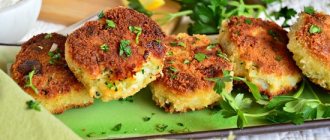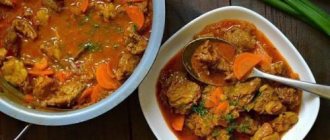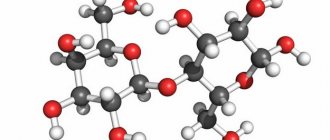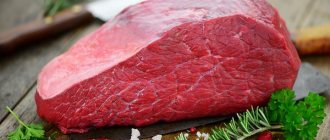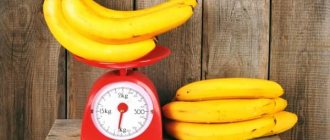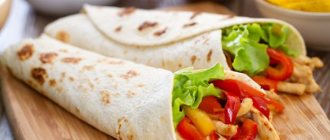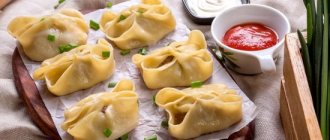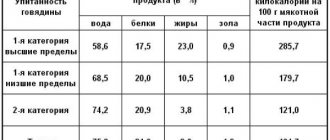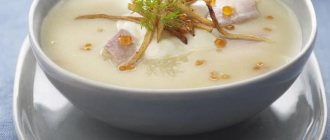General information about cutlets
Initially, a cutlet was a portioned piece of meat cooked on the bone. Then they began to prepare this dish from finely chopped meat. In the end we came to minced meat.
The dish is prepared from any meat. If the meat is lean, add some lard to the minced meat. There are options for vegetable (carrot, cabbage, mushroom, potato), fish and sweet (rice with honey, dried fruits, nuts) cutlets.
Nutritional and energy value depends on the ingredients and processing method.
The most common products are made from pork or beef.
Beef contains a lot of easily digestible iron. The product is also rich in protein, vitamin B12, and zinc. Beef is indispensable for iron deficiency anemia, and its components are necessary for the growth and regeneration of joint tissue. Positively affects the immune system.
There are many cooking options. Usually minced meat is mixed with chopped onion, egg and spices. Add bread, milk, garlic, grated potatoes, carrots, cheese. Fry in vegetable oil. But steaming is also possible.
Steamed cutlets are suitable for those who adhere to the principles of a healthy diet. They retain the maximum amount of nutrition with fewer calories.
Preference should be given to home-cooked dishes. Moreover, it is also advisable to make minced meat yourself. In a store-bought product, you cannot be sure of the quality of the meat and the absence of harmful additives.
How to improve the taste of cutlets
To improve the taste of the cutlets, make them juicy and soft, one of the following ingredients should be added to the minced meat:
- pieces of white bread (in a ratio of 1:10), dipped in cream or milk; R
- scallions in a ratio of 1:2 (1 part onion, 2 parts meat);
- various vegetables in a 1:2 ratio (carrots, zucchini, eggplant, potatoes, cabbage).
As a side dish, you can serve any vegetable puree, cereal porridge, boiled, fresh or steamed vegetables, pasta, canned peas, and herbs. The taste of meat cutlets goes well with all kinds of pickles: sauerkraut, barrel cucumbers, pickled tomatoes.
How many calories are in a beef patty?
A fried beef cutlet contains 200–260 kcal per 100 g; if steamed, 170 kcal. With a low calorie content, the dish is rich in protein and iron. Another indisputable advantage is that beef meat is easily absorbed by the body.
Beef is a dietary meat. Dishes made from it are perfect for feeding children, pregnant and lactating women. Eating beef is also allowed in weight loss diets.
Beef cutlets recipe:
- Prepare minced beef, 200–300 g.
- Peel a medium onion and grate it.
- Soak a slice of white bread (preferably a loaf) without skin in a small amount of milk or water. After 5-7 minutes, remove, squeeze lightly and knead until mushy.
- Beat 1 chicken egg into the prepared minced meat, add the prepared bread and onions. Salt and pepper to taste.
- To stir thoroughly. Form colettes.
- Roll the products in flour and fry on both sides in a small amount of vegetable oil.
1 serving (approximately 70 g) according to this recipe contains only 140 kcal.
How many calories are in a pork cutlet?
Pork is one of the most controversial types of meat that are included in the regular diet of modern man. Some consider it tasty and healthy, despite its fat content, others try in every possible way to avoid eating pork.
It is completely unreasonable to refuse it. Pork meat and lard contain a lot of useful substances, the most valuable of which are arachidonic acid and selenium. The first regulates hormonal balance, has a beneficial effect on the brain, and has a positive effect on blood clotting. As for selenium, it is a powerful substance in its healing properties. It prolongs the youth of the body by renewing cells, increases efficiency, relieves depression, and strengthens nerves.
In addition, pork meat, like chicken, contains many vitamins (the presence of all B vitamins is especially valuable) and a powerful mineral complex. Pork is very good for pregnant and lactating women, as it helps saturate the body with proteins and nutrients, and also enhances lactation.
Most nutritionists do not see anything wrong with eating pork if the amount does not exceed 200 grams per day. Contrary to popular belief, pork meat is perfectly absorbed by the body, especially if it is eaten not as a kebab paired with strong drinks, but as a tender cutlet.
Another question is that pork can be cooked in different ways. If, in addition to the calorie content (quite high) that a piece of brisket has, you add the calorie content of oil when frying in a frying pan, then under the guise of a fried cutlet dripping with juices, you can get a real calorie bomb.
How many calories are in a pork cutlet also depends on three factors: what part of the carcass the minced meat is made from, what additional ingredients are in it and what is the method of preparing the cutlets. The average calorie values are as follows:
• a cutlet fried in oil “weighs” in terms of calories from 345 to 360 kcal;
• a steamed cutlet has approximately 290 kcal per 100 g of finished dish.
Considering that it is not recommended to eat more than 200 g of pork meat, then one cutlet weighing 80 g is enough to get the required amount of zinc, magnesium, selenium, arachidonic acid, vitamins PP, B and other useful substances.
Calorie content of pork cutlet
100 g of the finished product contains an average of 300–345 kcal. One product usually weighs 70–80 g.
Pork is a fairly heavy product for the body. Even with a minimum of additives, a pork cutlet is much more calorie than any other. It is not recommended to consume this type of meat for people with gastrointestinal problems, weakened liver or pancreas.
But such cutlets contain calcium, phosphorus, selenium, sulfur, copper and iron. In addition, the dish has a good taste. You can reduce calories by steaming. A steam cutlet will “weigh” 220–280 kcal.
The classic recipe for pork cutlets is identical to the cooking method for beef. Only minced meat is made from pork meat. 1 serving contains 230–250 kcal.
Initially, this was the name for a piece of meat on the bone, but in the 19th century, taverns began to serve juicy “chopped cutlets” that everyone liked. For example, even A.S. Pushkin, in poetic form, recommended trying “Pozharsky Cutlets” from an innkeeper in Torzhok to one of his friends.
Although the dish was borrowed from Europeans, it is considered Russian, since its preparation recipe was completely changed over time.
The benefits and harms of cutlets
The benefits and harms of cutlets are determined by the type of meat used to prepare them.
- Beef is a source of complete iron and protein
, which is very useful for hematopoiesis and saturating the body with oxygen.
In addition, the vitamin B12 present in it promotes the complete and rapid absorption of iron. Collagen contained in beef is involved in the “construction” of interarticular ligaments, and zinc helps improve immunity. Moreover, all fried foods contain carcinogens that cause cancer; beef meat contains cholesterol
, which can trigger the development of cardiovascular diseases. - Pork is rich in magnesium and zinc, which help the functioning of blood vessels and the heart
, fats restore strength, and lysine forms bone tissue.
Selenium and arachidonic acid “treat” depression and improve the process of cell renewal in the body. At the same time, you should avoid eating pork if you have vascular or heart disease, since meat contains a huge amount of cholesterol. Histamines can cause allergies
and all kinds of inflammatory processes of the skin. Poorly cooked pork may contain helminths. - Chicken meat is good for the nervous system, heart, immunity, helps regulate cholesterol levels
, and nourishes the body with easily digestible vitamins, amino acids and microelements. Indicated for elderly people, children weakened by long-term illnesses. Helps reduce acidity, thereby relieving pain from gastritis and stomach ulcers. You should not overeat chicken meat, otherwise putrefactive processes in the intestines may be activated. And people with individual protein intolerance should avoid chicken.
And, of course, the healthiest cutlets are homemade steamed cutlets made from fresh meat. In addition, the calorie content of homemade cutlets is significantly lower than store-bought ones.
Calorie content of cutlets
The table shows data on cutlets weighing 60 g.
The calorie content of cutlets from different types of meat is averaged.
| Calorie content per 100g | Calorie content of 1 piece | |
| Calorie content of fried cutlets | ||
| Calorie content of chicken cutlet | 119 kcal | 71 kcal |
| Calorie content of fish cutlet | 164 kcal | 97 kcal |
| Calorie content of vegetable cutlet | 105 kcal | 63 kcal |
| Calorie content of pork cutlet | 345 kcal | 207 kcal |
| Beef cutlet calories | 234 kcal | 140 kcal |
| Calorie content | 267 kcal | 160 kcal |
| Turkey cutlet calories | 184 kcal | 110 kcal |
| of steamed cutlets | ||
| Calorie content of chicken cutlet | 84 kcal | 50 kcal |
| Calorie content of fish cutlet | 125 kcal | 75 kcal |
| Calorie content of vegetable cutlet | 52 kcal | 31 kcal |
| Calorie content of pork cutlet | 290 kcal | 174 kcal |
| Beef cutlet calories | 172 kcal | 103 kcal |
| Calorie content of pork and beef cutlets | 198 kcal | 119 kcal |
| Turkey cutlet calories | 145 kcal | 87 kcal |
How to improve the taste of cutlets
To improve the taste of the cutlets, make them juicy and soft, you should add
any of the following ingredients:
- pieces of white bread (in a ratio of 1:10), dipped in cream or milk;
- onions in a ratio of 1:2 (1 part onion, 2 parts meat);
- various vegetables in a 1:2 ratio (carrots, zucchini, eggplant, potatoes, cabbage).
As a side dish, you can serve any vegetable puree, cereal porridge, boiled, fresh or steamed vegetables, pasta, canned peas, and herbs. The taste of
clear cutlets goes well with all kinds of pickles
: sauerkraut, barrel cucumbers, pickled tomatoes.
This article contains information about the calorie content of cutlets made from different types of meat and fish.
The love for cutlets appears in childhood and continues throughout life. It’s so delicious when pieces of tender meat melt in your mouth. But you need to remember that this dish is very high in calories, especially if you want to lose weight. From this article you will learn how many calories are in cutlets from different types of meat, and what kind of meat can be used to prepare this dish for people who want to lose weight.
The benefits and harms of cutlets
The benefits and harms of cutlets are determined by the type of meat used to prepare them.
- Beef is a source of complete iron and protein, which is very useful for hematopoiesis and saturating the body with oxygen. In addition, the vitamin B12 present in it promotes the complete and rapid absorption of iron. Collagen contained in beef is involved in the “construction” of interarticular ligaments, and zinc helps improve immunity. Moreover, all fried foods contain carcinogens that cause cancer; beef meat contains cholesterol, which can provoke the development of cardiovascular diseases.
- Pork is rich in magnesium and zinc, which help the functioning of blood vessels and the heart, fats restore strength, and lysine forms bone tissue. Selenium and arachidonic acid “treat” depression and improve the process of cell renewal in the body. At the same time, you should avoid eating pork if you have vascular or heart disease, since meat contains a huge amount of cholesterol. Histamines can cause allergies and all kinds of inflammatory processes of the skin. Poorly cooked pork may contain helminths.
- Chicken meat is good for the nervous system, heart, immunity, helps regulate cholesterol levels, and nourishes the body with easily digestible vitamins, amino acids and microelements. Indicated for elderly people, children weakened by long-term illnesses. Helps reduce acidity, thereby relieving pain from gastritis and stomach ulcers. You should not overeat chicken meat, otherwise putrefactive processes in the intestines may be activated. And people with individual protein intolerance should avoid chicken.
And, of course, the healthiest cutlets are homemade steamed cutlets made from fresh meat. In addition, the calorie content of homemade cutlets is significantly lower than store-bought ones.
Green buckwheat as a side dish
How many calories are in fried, baked and steamed meat and fish cutlets?
Cutlets made even from the same type of meat will have different calorie content. For example, the calorie content of chicken cutlets made from the meat of the entire chicken carcass along with the skin is 190 cal per 100 grams. A cutlet made only from chicken breast will have a low calorie content - no more than 115 kcal. The calorie content also depends on the products that are additionally added to the minced meat: lard, milk, bread, eggs, and so on.
Remember:
The more products you add to the cutlet mince besides meat, the higher the calorie content of the cutlets at the end.
If you need to make the minced meat more elastic, but you don’t want to add milk and bread, then you can add a little water. Instead of whole eggs, use just the whites. This will help reduce calories.
Meat cutlets contain from 120 kcal to 360 kcal, depending on the type of meat. In fish, depending on the type of fish, from 110 kcal to 270 kcal.
Now let's take a closer look at how many calories are in fried, baked and steamed meat and fish cutlets.
How many calories are in a chicken cutlet?
There are several ways to prepare ready-made cutlets: frying, baking and steaming. If meat is fried in oil, the calorie content of the dish increases by almost 30%. Not only very slim people, but also very healthy people can afford unlimited quantities of fried cutlets. For those who suffer from high cholesterol, heart and vascular diseases, or have problems with the stomach and pancreas, this dish is not suitable.
Steaming cutlets is the healthiest method, which also practically does not change the calorie content of raw minced meat. In turn, cutlets made from any meat or fish can also have different calorie content. It depends on what kind of meat was used (fatty or lean), what additional ingredients the housewife added to the minced meat.
Let's take, for example, valuable, tasty and low-calorie chicken meat. This is a real gift for people losing weight: it is dietary, that is, not at all fatty, easily digestible, and tasty in almost any form. But if you make cutlets from different parts of chicken meat, their calorie content initially (that is, before cooking) will be different:
• meat cut from all parts of the carcass (including skin) will give 190 kcal;
• cutlet made from skinless chicken breast only – 115 kcal.
How many calories are in the cutlet will depend on the composition of the minced meat. If we add additional ingredients to the meat (white bread, semolina, onions, flour), the calorie content will change. Moreover, sometimes it can be changed either upward (for example, by adding high-calorie semolina) or downward. In the latter case, the minced meat can be diluted with low-calorie vegetables, such as onions and carrots, and water or milk can be added.
Meat fried in oil has the highest calorie content. To somehow reduce it, you can fry the cutlets over low heat, under a tightly closed lid, adding literally a teaspoon of oil to the frying pan. Of course, if the frying is normal, then the cutlet should simmer deliciously in a generous portion of oil. Very tasty, but high in calories.
Steaming is an ideal solution for people who are watching their health and weight. The formed cutlets will remain to be sent to a double boiler or multicooker. No oil or flour is required for frying. Of course, you won’t get a crispy crust, but there won’t be any damage to the liver or blood vessels either.
So how many calories are in a chicken cutlet? Depending on the composition of the minced meat and the cooking method, the data will vary slightly:
• fried cutlet contains from 120 to 250 kcal per 100 g;
• steamed cutlet contains from 85 to 130 kcal per 100 g.
Dietary chicken meat is very beneficial for the heart and nervous system. It gives the body strength, normalizes cholesterol levels, provides essential amino acids, microelements and vitamins, reduces the acidity of gastric juice, easing the condition of patients with gastritis and ulcers.
Chicken meat is indispensable for people losing weight. It provides the body with complete protein without overloading it with calories. Steamed chicken cutlets are good for children and the weak or elderly. For greater benefits, they should be served with fresh or grilled vegetables. For those who are not afraid of extra calories, mashed potatoes, rice, and buckwheat can be a side dish for a fried chicken cutlet.
Which cutlets are healthier and healthier for weight loss?
When a person is on a diet and needs to lose weight, it is important to know which foods can be eaten and which ones it is better to refrain from eating. Which cutlets are healthier and healthier for weight loss?
- Nutritionists around the world say that fried food is harmful to health,
as it contains many carcinogens and has a pathological risk of cancer. - The high fat content
in fried meat leads to heart and vascular diseases. - Frying greatly increases the calorie content of even the most dietary meat
: turkey, chicken or beef. Therefore, steamed cutlets are healthier and healthier for weight loss. - If we talk about meat, then pork has a lot of fat
. People who want to lose weight should not eat pork cutlets. - Cutlets made from pike and pink salmon are high in calories
- these are fatty fish.
Conclusion:
For weight loss and health, steamed cutlets made from chicken breast or turkey fillet are healthier. Among the fish you should give preference: hake, cod and pollock.
Monitor your weight and health to save yourself from chronic diseases associated with blood vessels and heart.
Pork cutlet: calorie content, BJU
Most people who are losing weight know the BZHU formula very well. Daily caloric intake during weight loss should consist of 30-35% protein foods. The source of protein is meat, including pork.
Protein is especially important when gaining muscle mass. This is the main building material for a beautiful body contour. Therefore, when playing sports, meat should be a must in the diet.
Of course, it is best to prefer dishes made from veal, turkey or chicken. This is dietary meat with a minimal percentage of fat. But if you don’t exceed your individually calculated calorie intake, you can eat a few pork cutlets for lunch.
Fried cutlet
Calorie content of fried pork cutlets per 100 grams is 230 kcal.
Of them:
- 13 grams of proteins;
- 16 grams of fat.
- 2 grams of carbohydrates.
Steamed cutlet
The calorie content of steamed pork cutlets is 190 kcal per 100 grams.
Of them:
- 12 gr. proteins;
- 13 grams of fat;
- 5 grams of carbohydrates.
Pork and beef cutlet
Calorie content of meat cutlets per 100 g is 204 kcal.
Of them:
- proteins – 13 g;
- fats – 14 g;
- carbohydrates – 2 gr.
Video: BUCKWHEAT PATTIES - lean BUCKWHEAT PATTIES without eggs from Marmaladnaya Lisitsa/VEGAN BUCKWHEAT PATTIES
CHEMICAL COMPOSITION AND NUTRITIONAL ANALYSIS
Nutritional value and chemical composition "Pork chops, 1-414 each".
The table shows the nutritional content (calories, proteins, fats, carbohydrates, vitamins and minerals) per 100 grams of edible portion.
| Nutrient | Quantity | Norm** | % of the norm in 100 g | % of the norm in 100 kcal | 100% normal |
| Calorie content | 470 kcal | 1684 kcal | 27.9% | 5.9% | 358 g |
| Squirrels | 17.5 g | 76 g | 23% | 4.9% | 434 g |
| Fats | 40.3 g | 60 g | 67.2% | 14.3% | 149 g |
| Carbohydrates | 8.8 g | 211 g | 4.2% | 0.9% | 2398 g |
| Alimentary fiber | 0.9 g | 20 g | 4.5% | 1% | 2222 g |
| Water | 30.2 g | 2400 g | 1.3% | 0.3% | 7947 g |
| Ash | 2.2 g | ~ | |||
| Vitamins | |||||
| Vitamin A, RE | 10 mcg | 900 mcg | 1.1% | 0.2% | 9000 g |
| Retinol | 0.01 mg | ~ | |||
| Vitamin B1, thiamine | 0.83 mg | 1.5 mg | 55.3% | 11.8% | 181 g |
| Vitamin B2, riboflavin | 0.15 mg | 1.8 mg | 8.3% | 1.8% | 1200 g |
| Vitamin E, alpha tocopherol, TE | 0.7 mg | 15 mg | 4.7% | 1% | 2143 g |
| Vitamin RR, NE | 7 mg | 20 mg | 35% | 7.4% | 286 g |
| Niacin | 2.9 mg | ~ | |||
| Macronutrients | |||||
| Potassium, K | 183 mg | 2500 mg | 7.3% | 1.6% | 1366 g |
| Calcium, Ca | 25 mg | 1000 mg | 2.5% | 0.5% | 4000 g |
| Magnesium, Mg | 27 mg | 400 mg | 6.8% | 1.4% | 1481 g |
| Sodium, Na | 572 mg | 1300 mg | 44% | 9.4% | 227 g |
| Phosphorus, Ph | 183 mg | 800 mg | 22.9% | 4.9% | 437 g |
| Microelements | |||||
| Iron, Fe | 2.4 mg | 18 mg | 13.3% | 2.8% | 750 g |
| Digestible carbohydrates | |||||
| Starch and dextrins | 8.2 g | ~ | |||
| Mono- and disaccharides (sugars) | 0.2 g | max 100 g | |||
| Sterols (sterols) | |||||
| Cholesterol | 97 mg | max 300 mg | |||
| Saturated fatty acids | |||||
| Saturated fatty acids | 14.6 g | max 18.7 g |
The energy value is 470 kcal.
Main source: Skurikhin I.M. and others. Chemical composition of food products. .
** This table shows the average levels of vitamins and minerals for an adult. If you want to know the norms taking into account your gender, age and other factors, then use the My Healthy Diet app.
Recipe: Stewed cutlets. Calorie, chemical composition and nutritional value.
Nutritional value and chemical composition of “Stewed cutlets”.
The table shows the nutritional content (calories, proteins, fats, carbohydrates, vitamins and minerals) per 100 grams of edible portion.
| Nutrient | Quantity | Norm** | % of the norm in 100 g | % of the norm in 100 kcal | 100% normal |
| Calorie content | 294.1 kcal | 1684 kcal | 17.5% | 6% | 573 g |
| Squirrels | 31.3 g | 76 g | 41.2% | 14% | 243 g |
| Fats | 18.2 g | 56 g | 32.5% | 11.1% | 308 g |
| Carbohydrates | 1.2 g | 219 g | 0.5% | 0.2% | 18250 g |
| Alimentary fiber | 0.5 g | 20 g | 2.5% | 0.9% | 4000 g |
| Water | 48.3 g | 2273 g | 2.1% | 0.7% | 4706 g |
| Ash | 0.454 g | ~ | |||
| Vitamins | |||||
| Vitamin B1, thiamine | 0.008 mg | 1.5 mg | 0.5% | 0.2% | 18750 g |
| Vitamin B2, riboflavin | 0.003 mg | 1.8 mg | 0.2% | 0.1% | 60000 g |
| Vitamin B4, choline | 0.92 mg | 500 mg | 0.2% | 0.1% | 54348 g |
| Vitamin B5, pantothenic | 0.015 mg | 5 mg | 0.3% | 0.1% | 33333 g |
| Vitamin B6, pyridoxine | 0.018 mg | 2 mg | 0.9% | 0.3% | 11111 g |
| Vitamin B9, folates | 1.364 mcg | 400 mcg | 0.3% | 0.1% | 29326 g |
| Vitamin C, ascorbic acid | 1.52 mg | 90 mg | 1.7% | 0.6% | 5921 g |
| Vitamin E, alpha tocopherol, TE | 0.03 mg | 15 mg | 0.2% | 0.1% | 50000 g |
| Vitamin H, biotin | 0.136 mcg | 50 mcg | 0.3% | 0.1% | 36765 g |
| Vitamin K, phylloquinone | 0.1 mcg | 120 mcg | 0.1% | 120000 g | |
| Vitamin RR, NE | 0.0758 mg | 20 mg | 0.4% | 0.1% | 26385 g |
| Niacin | 0.03 mg | ~ | |||
| Macronutrients | |||||
| Potassium, K | 26.54 mg | 2500 mg | 1.1% | 0.4% | 9420 g |
| Calcium, Ca | 5.81 mg | 1000 mg | 0.6% | 0.2% | 17212 g |
| Silicon, Si | 0.758 mg | 30 mg | 2.5% | 0.9% | 3958 g |
| Magnesium, Mg | 2.19 mg | 400 mg | 0.5% | 0.2% | 18265 g |
| Sodium, Na | 117.91 mg | 1300 mg | 9.1% | 3.1% | 1103 g |
| Sera, S | 10.39 mg | 1000 mg | 1% | 0.3% | 9625 g |
| Phosphorus, P | 9 mg | 800 mg | 1.1% | 0.4% | 8889 g |
| Chlorine, Cl | 184.67 mg | 2300 mg | 8% | 2.7% | 1245 g |
| Microelements | |||||
| Aluminium, Al | 60.6 mcg | ~ | |||
| Bor, B | 30.3 mcg | ~ | |||
| Iron, Fe | 0.13 mg | 18 mg | 0.7% | 0.2% | 13846 g |
| Yod, I | 0.45 mcg | 150 mcg | 0.3% | 0.1% | 33333 g |
| Cobalt, Co | 0.803 mcg | 10 mcg | 8% | 2.7% | 1245 g |
| Manganese, Mn | 0.0356 mg | 2 mg | 1.8% | 0.6% | 5618 g |
| Copper, Cu | 13.7 mcg | 1000 mcg | 1.4% | 0.5% | 7299 g |
| Molybdenum, Mo | 0.333 mcg | 70 mcg | 0.5% | 0.2% | 21021 g |
| Nickel, Ni | 0.455 mcg | ~ | |||
| Rubidium, Rb | 72.1 mcg | ~ | |||
| Selenium, Se | 0.076 mcg | 55 mcg | 0.1% | 72368 g | |
| Fluorine, F | 4.7 mcg | 4000 mcg | 0.1% | 85106 g | |
| Chromium, Cr | 0.3 mcg | 50 mcg | 0.6% | 0.2% | 16667 g |
| Zinc, Zn | 0.1306 mg | 12 mg | 1.1% | 0.4% | 9188 g |
| Digestible carbohydrates | |||||
| Starch and dextrins | 0.015 g | ~ | |||
| Mono- and disaccharides (sugars) | 1.2 g | max 100 g | |||
| Glucose (dextrose) | 0.197 g | ~ | |||
| Sucrose | 0.985 g | ~ | |||
| Fructose | 0.182 g | ~ | |||
| Essential amino acids | 0.043 g | ~ | |||
| Arginine* | 0.024 g | ~ | |||
| Valin | 0.004 g | ~ | |||
| Histidine* | 0.002 g | ~ | |||
| Isoleucine | 0.006 g | ~ | |||
| Leucine | 0.008 g | ~ | |||
| Lysine | 0.009 g | ~ | |||
| Methionine | 0.002 g | ~ | |||
| Methionine + Cysteine | 0.003 g | ~ | |||
| Threonine | 0.006 g | ~ | |||
| Tryptophan | 0.003 g | ~ | |||
| Phenylalanine | 0.006 g | ~ | |||
| Phenylalanine+Tyrosine | 0.011 g | ~ | |||
| Nonessential amino acids | 0.1 g | ~ | |||
| Alanin | 0.009 g | ~ | |||
| Aspartic acid | 0.011 g | ~ | |||
| Glycine | 0.006 g | ~ | |||
| Glutamic acid | 0.033 g | ~ | |||
| Proline | 0.005 g | ~ | |||
| Serin | 0.004 g | ~ | |||
| Tyrosine | 0.005 g | ~ | |||
| Cysteine | 0.002 g | ~ |
The energy value of stewed cutlets is 294.1 kcal.
Primary Source: Created in the application by the user. Read more.
** This table shows the average levels of vitamins and minerals for an adult. If you want to know the norms taking into account your gender, age and other factors, then use the “My Healthy Diet” application.
Product calorie analysis
SHARE OF BZHU IN CALORIES
Ratio of proteins, fats and carbohydrates:
Knowing the contribution of proteins, fats and carbohydrates to calorie content, you can understand how well a product or diet meets the standards of a healthy diet or the requirements of a certain diet. For example, the US and Russian Departments of Health recommend 10-12% of calories come from protein, 30% from fat and 58-60% from carbohydrates. The Atkins diet recommends low carbohydrate intake, although other diets focus on low fat intake.
If more energy is expended than it is received, the body begins to use up fat reserves, and body weight decreases.
Try filling out your food diary right now without registration.
Find out your additional calorie expenditure for training and get updated recommendations absolutely free.
DATE FOR ACHIEVEMENT OF THE GOAL
Pork chops, 1-414 each
rich in vitamins and minerals such as: vitamin B1 - 55.3%, vitamin PP - 35%, phosphorus - 22.9%, iron - 13.3%
- Vitamin B1
is part of the most important enzymes of carbohydrate and energy metabolism, providing the body with energy and plastic substances, as well as the metabolism of branched amino acids. A lack of this vitamin leads to serious disorders of the nervous, digestive and cardiovascular systems. - Vitamin PP
is involved in redox reactions of energy metabolism. Insufficient vitamin intake is accompanied by disruption of the normal condition of the skin, gastrointestinal tract and nervous system. - Phosphorus
takes part in many physiological processes, including energy metabolism, regulates acid-base balance, is part of phospholipids, nucleotides and nucleic acids, and is necessary for the mineralization of bones and teeth. Deficiency leads to anorexia, anemia, and rickets. - Iron
is part of proteins with various functions, including enzymes. Participates in the transport of electrons and oxygen, ensures the occurrence of redox reactions and activation of peroxidation. Insufficient consumption leads to hypochromic anemia, myoglobin deficiency atony of skeletal muscles, increased fatigue, myocardiopathy, and atrophic gastritis.
more hide
You can look at the complete directory of the healthiest foods in the application Energy value, or calorie content
- this is the amount of energy released in the human body from food during the digestion process. The energy value of the product is measured in kilocalories (kcal) or kilojoules (kJ) per 100 grams. product. The kilocalorie used to measure the energy value of food is also called a food calorie, so when caloric content is reported in (kilo)calories, the prefix kilo is often omitted. You can see detailed energy value tables for Russian products.
The nutritional value
— content of carbohydrates, fats and proteins in the product.
Nutritional value of food product
- a set of properties of a food product, in the presence of which the physiological needs of a person for the necessary substances and energy are satisfied.
Vitamins
, organic substances required in small quantities in the diet of both humans and most vertebrates. Vitamin synthesis is usually carried out by plants, not animals. A person's daily requirement for vitamins is only a few milligrams or micrograms. Unlike inorganic substances, vitamins are destroyed by strong heat. Many vitamins are unstable and are “lost” during cooking or food processing.
Cutlets are a fairly high-calorie dish and are rarely used in a healthy diet. However, this dish can be dietary and low-calorie. To enjoy the taste of cutlets and maintain your figure, it is advisable to choose lean beef or lamb and not eat pork. Instead of frying, it is recommended to cook the dish in a double boiler, slow cooker or oven. You can add vegetables to the meat cutlets or use them as a side dish.
IT IS IMPORTANT TO KNOW! Fortune teller Baba Nina:
“There will always be plenty of money if you put it under your pillow...” Read more >>
Homemade fried cutlet calorie content. Chemical composition and nutritional value.
Nutritional value and chemical composition of “home fried cutlet”.
The table shows the nutritional content (calories, proteins, fats, carbohydrates, vitamins and minerals) per 100 grams of edible portion.
| Nutrient | Quantity | Norm** | % of the norm in 100 g | % of the norm in 100 kcal | 100% normal |
| Calorie content | 230 kcal | 1684 kcal | 13.7% | 6% | 732 g |
| Squirrels | 15 g | 76 g | 19.7% | 8.6% | 507 g |
| Fats | 17.6 g | 56 g | 31.4% | 13.7% | 318 g |
| Carbohydrates | 3 g | 219 g | 1.4% | 0.6% | 7300 g |
| Organic acids | 44.4 g | ~ | |||
| Alimentary fiber | 1.6 g | 20 g | 8% | 3.5% | 1250 g |
| Water | 146.1 g | 2273 g | 6.4% | 2.8% | 1556 g |
| Ash | 2.2 g | ~ | |||
| Vitamins | |||||
| Vitamin A, RE | 40 mcg | 900 mcg | 4.4% | 1.9% | 2250 g |
| Retinol | 0.04 mg | ~ | |||
| Vitamin B1, thiamine | 0.09 mg | 1.5 mg | 6% | 2.6% | 1667 g |
| Vitamin B2, riboflavin | 0.2 mg | 1.8 mg | 11.1% | 4.8% | 900 g |
| Vitamin B4, choline | 107.7 mg | 500 mg | 21.5% | 9.3% | 464 g |
| Vitamin B5, pantothenic | 0.8 mg | 5 mg | 16% | 7% | 625 g |
| Vitamin B6, pyridoxine | 0.6 mg | 2 mg | 30% | 13% | 333 g |
| Vitamin B9, folates | 15.1 mcg | 400 mcg | 3.8% | 1.7% | 2649 g |
| Vitamin B12, cobalamin | 4 mcg | 3 mcg | 133.3% | 58% | 75 g |
| Vitamin C, ascorbic acid | 2.2 mg | 90 mg | 2.4% | 1% | 4091 g |
| Vitamin E, alpha tocopherol, TE | 2.1 mg | 15 mg | 14% | 6.1% | 714 g |
| Vitamin H, biotin | 4.8 mcg | 50 mcg | 9.6% | 4.2% | 1042 g |
| Vitamin RR, NE | 10.593 mg | 20 mg | 53% | 23% | 189 g |
| Niacin | 4.7 mg | ~ | |||
| Macronutrients | |||||
| Potassium, K | 619.4 mg | 2500 mg | 24.8% | 10.8% | 404 g |
| Calcium, Ca | 28.3 mg | 1000 mg | 2.8% | 1.2% | 3534 g |
| Silicon, Si | 0.05 mg | 30 mg | 0.2% | 0.1% | 60000 g |
| Magnesium, Mg | 42 mg | 400 mg | 10.5% | 4.6% | 952 g |
| Sodium, Na | 124.7 mg | 1300 mg | 9.6% | 4.2% | 1043 g |
| Sera, S | 439.4 mg | 1000 mg | 43.9% | 19.1% | 228 g |
| Phosphorus, P | 378.4 mg | 800 mg | 47.3% | 20.6% | 211 g |
| Chlorine, Cl | 798.1 mg | 2300 mg | 34.7% | 15.1% | 288 g |
| Microelements | |||||
| Aluminium, Al | 65 mcg | ~ | |||
| Bor, B | 26.9 mcg | ~ | |||
| Vanadium, V | 1 mcg | ~ | |||
| Iron, Fe | 5 mg | 18 mg | 27.8% | 12.1% | 360 g |
| Yod, I | 13.8 mcg | 150 mcg | 9.2% | 4% | 1087 g |
| Cobalt, Co | 13.9 mcg | 10 mcg | 139% | 60.4% | 72 g |
| Manganese, Mn | 0.105 mg | 2 mg | 5.3% | 2.3% | 1905 |
| Copper, Cu | 354.2 mcg | 1000 mcg | 35.4% | 15.4% | 282 g |
| Molybdenum, Mo | 23 mcg | 70 mcg | 32.9% | 14.3% | 304 g |
| Nickel, Ni | 16.4 mcg | ~ | |||
| Tin, Sn | 140.9 mcg | ~ | |||
| Rubidium, Rb | 63 mcg | ~ | |||
| Selenium, Se | 0.07 mcg | 55 mcg | 0.1% | 78571 g | |
| Titanium, Ti | 0.1 mcg | ~ | |||
| Fluorine, F | 121.6 mcg | 4000 mcg | 3% | 1.3% | 3289 g |
| Chromium, Cr | 15.5 mcg | 50 mcg | 31% | 13.5% | 323 g |
| Zinc, Zn | 6.1561 mg | 12 mg | 51.3% | 22.3% | 195 g |
| Digestible carbohydrates | |||||
| Starch and dextrins | 0.8 g | ~ | |||
| Mono- and disaccharides (sugars) | 1.2 g | max 100 g |
The energy value of a home-fried cutlet is 230 kcal.
Primary Source: Created in the application by the user. Read more.
** This table shows the average levels of vitamins and minerals for an adult. If you want to know the norms taking into account your gender, age and other factors, then use the “My Healthy Diet” application.
Composition of cutlets from different types of meat
In general, the ratio of BJU in cutlets is presented in the following proportions:
BJU in cutlets
| Type of meat | Composition, benefits and harm of individual elements |
| Beef | Beef contains a large amount of complete protein and iron, due to which the human body is saturated with oxygen, which has a beneficial effect on the functioning of the hematopoietic system. Vitamin B12 helps quickly and fully absorb iron. The type of meat in question contains a lot of collagen, which is one of the “building” materials for interarticular ligaments. High levels of zinc help improve the functioning of the human immune system and strengthen defenses. But beef meat contains cholesterol, which is the cause of the development of cardiovascular pathologies. |
| Pork | Pork contains large amounts of magnesium and zinc, which are essential for normal heart function. High levels of lysine ensure the formation of bone tissue. Thanks to selenium and arachidonic acid, a person gets rid of depression, and the cells of the body are renewed. However, this type of meat, like beef, contains a lot of cholesterol and is characterized by high levels of histamine. It causes various allergic reactions and inflammatory processes of the skin. |
| Chicken | Chicken meat has a beneficial effect on the functioning of the nervous system, normalizes cholesterol levels, and saturates the body with vitamins and microelements. Chicken helps reduce stomach acid levels |
| Mutton | Lamb contains much more iron than other types of meat. Therefore, it is recommended for use by those who suffer from anemia. In addition, meat contains large quantities of vitamins PP, B1, E, B2, B9, B5, B6. Lamb is rich in macroelements such as calcium, potassium, sodium, phosphorus. Fluoride contained in lamb helps fight tooth decay and keeps teeth in good condition. |
| Turkey | Turkey meat protein is 95% digestible and contains little cholesterol. It contains a lot of potassium and polyunsaturated acids, which has a beneficial effect on the functioning of the cardiovascular system. The level of phosphorus is the same as in fish. Therefore, it is indicated to prevent joint problems. Zinc helps men eliminate sexual problems |
| Fish | The benefit of fish cutlet lies in the fact that fish contains omega-3 and omega-6 fatty acids, which are not found in other products. These substances lower blood cholesterol levels, which has a beneficial effect on the cardiovascular system. Fish with low fat content helps normalize weight. But there are often cases when salts of heavy metals and toxic substances are found in the tissues and organs of river and sea fish, which contaminate the water in which they live |
How many calories are in a beef cutlet?
It is believed that beef is healthier and safer than pork meat, since it contains less fat, and therefore fewer calories. This is partly true: beef is actually a lean product compared to pink and white fatty pork. Before you find out how many calories are in a beef cutlet, you need to make sure of the benefits of this product.
Red beef contains complete protein and has a lot of iron, so beef patties should be included in the diet of people with low hemoglobin. In addition, beef contains a lot of collagen, which is extremely valuable for the human body, which prolongs the health of ligaments, as well as zinc, a microelement very useful for the immune system. Young beef is easily digested by the body. A beef cutlet contains amino acids and B vitamins, just like pork, it will perfectly satisfy hunger and provide long-lasting satiety.
We must not forget that any fried meat contains carcinogens, and therefore has a potential cancer risk. High cholesterol content in beef threatens the development of cardiovascular diseases. In addition, frying increases the calorie content of beef patties, despite their undoubted dietary benefits.
It is no coincidence that in order to prepare minced meat that is ideal in taste and calorie content, pork and beef are most often mixed in the proportion that seems most delicious.
How many calories are in a pure beef patty? If we take the average figures without taking into account additional ingredients, the approximate numbers are as follows:
beef cutlet fried in oil – 240-250 kcal;
steamed cutlet - from 140 to 170 kcal.
Quite modest compared to pork and quite comparable to chicken. This means that beef cutlets are preferable when following a diet, especially steamed ones. One cutlet will not harm your figure, but will fill you up for a long time. You can serve beef with a salad of fresh vegetables (this is the healthiest option for the body) or any other side dish.
Calorie content
To correctly calculate the calories in cutlets, you need to consider what ingredients they are made from and the cooking method. The table presents data on the number of kilocalories per 100 g based on the assumption that 1 piece in finished form weighs about 60 grams.
Calorie content of fried cutlets
Cutlets fried in oil are considered the most high-calorie.
| Type of cutlet | kcal per 100 g | Calorie content per piece |
| From pork | ||
| Beef | ||
| From pork and beef | ||
| Homemade ground beef | ||
| Beef liver | ||
| Turkey fillet | ||
| Meatballs with rice | ||
| From minced meat with zucchini | ||
| Chicken balls | ||
| Pork balls | ||
| Beef chops | ||
| Chicken Kiev | ||
| From chicken breast | ||
| From lamb | ||
| Breaded sauerkraut | ||
| From cauliflower | ||
| Buckwheat | ||
| From oatmeal |
Calorie content of steamed cutlets
The calorie content of a steamed dish is significantly lower than that of fried cutlets.
Calorie content, BJU and nutritional value of beef cutlet
Photo: ru.freepik.com
Understanding the properties of this dish, it is worth distinguishing between the methods of preparing cutlets.
- Minced beef made from lean beef. 100 grams of minced meat contains 171 kcal, 26 g of protein, 6 g of fat and 0 g of carbohydrates, which is 9% of the recommended daily amount.
- Fried beef cutlet. Consider a dietary option: cutlets made from lean lean beef. On average, 100 grams contain about 217 kcal, 26 g of protein, 12 g of fat, 0 g of carbohydrates. Most fats are mono- and polyunsaturated.
- Steam cutlet. Compared to a fried one, a steamed cutlet is lower in calories, but its composition is different. 100 grams of product contains 164 kcal, 15 g of protein, 9 g of fat, 4 g of carbohydrates. Fats are mostly saturated, monounsaturated.
- Breaded cutlet. Contains 319 kcal, 17 g protein, 21 g fat, 15 g carbohydrates. Fat characteristics: 5 g – saturated, 8 g – monounsaturated, 5 g – polyunsaturated.
Principles of preparing a dietary dish
The greatest benefit for the digestive system and the human body comes from steamed food. The products do not come into contact with the surface, which is heated, and they do not have a crispy crust. In addition, no oil is used to prepare them. All these factors are the key to preparing a real dietary dish.
To properly prepare low-calorie steamed cutlets, you need to listen to simple recommendations:
- 1. Do not use pork, fatty lamb and beef. The meat cutlet should be prepared from chicken, lean veal and beef, rabbit, and fish.
- 2. In order for the cutlets to bring maximum benefits to the body and help maintain your figure, they can be cooked with the addition of vegetables and cereals.
- 3. For heat treatment of such dishes, it is necessary to use steamers, pans with grates (manto cookers). Modern multicookers are equipped with a steaming function.
- 4. If special utensils are not available, a regular saucepan with a small amount of water will do. A sieve with products should be placed on top of the container, which should be covered with a lid.
- 5. As a side dish, you need to use fresh, boiled or stewed vegetables.
The method for preparing delicious dietary cutlets is presented step by step in the recipes below.
Lean veal cutlets
The calorie content of this dish is 170 kilocalories per 100 g.
To prepare cutlets you need the following ingredients:
- 350 g minced veal;
- 150 g minced beef;
- 100 g milk;
- 2 eggs;
- 2 cloves of garlic;
- 100 g bread pulp;
- 1 onion;
- salt, spices, herbs - to taste.
Cooking method:
- 1. The minced meat is thoroughly mixed, after which onions, garlic, eggs, bread pulp soaked in milk, finely chopped herbs and spices are added. Everything gets mixed up again.
- 2. The baking sheet is covered with foil and greased with oil.
- 3. With wet hands, cutlets are formed and placed on a baking sheet.
- 4. Baking time in the oven is 20–25 minutes. The temperature for cooking cutlets is 180 degrees.
Steamed chicken cutlets in a slow cooker
The calorie content of steamed chicken meatballs is 129 kcal per 100 g.
Ingredients:
- 300 g chicken fillet;
- 100 g onions;
- 10 g garlic;
- 1 egg;
- 20 g sunflower oil;
- 20 g salad;
- salt, pepper - to taste.
Cooking method:
- 1. Using a meat grinder, grind the meat, onion, and garlic.
- 2. Add the remaining ingredients to the resulting minced meat and mix thoroughly.
- 3. Form cutlets and place them in a multicooker container.
- 4. To prepare, set the “Cooking” program for 20 minutes.
- 5. Before serving, place the cutlets on lettuce leaves.
Dietary steamed turkey cutlets
Turkey is the most dietary meat. To add juiciness to the cutlets, this recipe uses rolled oats, which successfully replaces bread or crackers. The calorie content of the dish per 100 g is 95 kilocalories.
Ingredients:
- 600 g turkey meat;
- 100 g low-fat sour cream;
- 1 onion;
- 1 carrot;
- 100 g oatmeal;
- salt, spices - to taste.
Cooking method:
- 1. Dilute sour cream with 3 tablespoons of warm water, add rolled oats and let swell for 20 minutes.
- 2. Grind turkey meat with onions using a meat grinder.
- 3. Add carrots grated on a coarse grater to the minced meat.
- 4. Mix oatmeal with minced meat, salt and pepper.
- 5. Form cutlets and place in the multicooker bowl.
- 6. Cook the dish in the “Steam” mode. Cooking time is 20 minutes.
Proper preparation of cutlets will allow you to enjoy the taste of this dish even for those who adhere to the principles of a healthy diet and watch their figure.
Tender chicken cutlets with cheese: composition, calorie content and nutritional value per 100 g
Grind the chicken fillet into minced meat, grate the cheese on a fine grater, finely chop the onion, and also finely chop the garlic. Place in a glass bowl. Add kefir, starch, salt, black pepper, paprika, finely chopped herbs and mix the minced meat thoroughly. With wet hands, form small cutlets and fry in a small amount of oil. Press the finished chicken cutlets with a paper towel to absorb excess oil. Cutlets are ready
Nutritional value and chemical composition of “Fried chicken cutlets with cheese.”
| Nutrient | Quantity | Norm** | % of the norm in 100 g | % of the norm in 100 kcal | 100% normal |
| Calorie content | 174.5 kcal | 1684 kcal | 10.4% | 6% | 965 g |
| Squirrels | 19.5 g | 76 g | 25.7% | 14.7% | 390 g |
| Fats | 5.7 g | 56 g | 10.2% | 5.8% | 982 g |
| Carbohydrates | 9.8 g | 219 g | 4.5% | 2.6% | 2235 g |
The energy value of fried chicken cutlets with cheese is 174.5 kcal.
Primary Source: Created in the application by the user. Read more.
** This table shows the average levels of vitamins and minerals for an adult. If you want to know the norms taking into account your gender, age and other factors, then use the “My Healthy Diet” application.
How to cook the dish “Chicken cutlets with cheese”
- Grate hard cheese on a coarse grater.
- Peel the onion, wash and chop very finely.
- Wash the greens and chop them.
- Place minced chicken in a bowl. Add eggs, grated cheese, chopped onions, herbs, mayonnaise (or sour cream), salt and pepper and mix. Add flour and mix well.
- Heat a frying pan, pour in vegetable oil. Place pancakes with a tablespoon into the hot oil.
- Fry chicken cutlets on both sides over low heat until golden brown, 4-5 minutes on each side.
- Minced chicken - 500 gr.
- Eggs - 5 pcs.
- Parmesan cheese - 50 gr.
- Onion - 1 pc.
- Mayonnaise - 3 tbsp. l.
- Salt (to taste) - 2 gr.
- Black pepper (to taste) - 2 gr.
- Greens - 20 gr.
- Flour - 3 tbsp. l.
- Vegetable oil - 30 ml.
Nutritional value of the dish “Chicken cutlets with cheese” (per 100 grams):
And a little about secrets...
The story of one of our readers, Irina Volodina:
I was especially distressed by my eyes, which were surrounded by large wrinkles, plus dark circles and puffiness. How to completely remove wrinkles and bags under the eyes? How to deal with swelling and redness? But nothing ages or rejuvenates a person more than his eyes.
But how to rejuvenate them? Plastic surgery? I found out - no less than 5 thousand dollars. Hardware procedures - photorejuvenation, gas-liquid peeling, radio lifting, laser facelift? A little more affordable - the course costs 1.5-2 thousand dollars. And when will you find time for all this? And it's still expensive. Especially now. Therefore, I chose a different method for myself...

